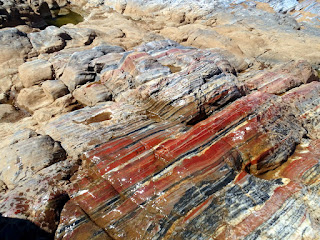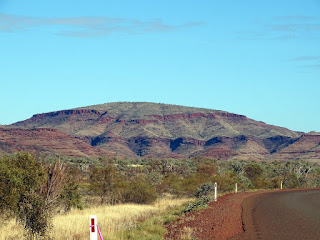Barn Hill is situated on Thangoo Station, a working cattle station of approx 430, 000 acres and stretches for 85 km along the coast between Broome and Port Hedland. The property runs 8000 head of Brahman cattle and is part of the live export trade from Broome.
Photo of our campsite on the top of the cliff - there is Winnie. Ahead is the ocean and the sunsets are amazing. You sit on the edge of the cliff and slowly watch the sun going down.
As well as the beach there was our favourite rock pool with permanent water in it. Apparently it used to be deeper but it gets filled up with sand.
We went there each day to wallow in it a bit. Safer than the surf :-)
The variety of rock formations along the beach is terrific. We think this is a mini-Uluru.
The combination of red and pink is also very eye-catching.
These rock formations are referred to as cathedral city. They are a much darker and redder colour than the other rocks along the cliffs.
As well as looking cathedral-like they also look slightly extra-terrestrial.
They reminded us a little of a place in the NT which is called the Lost City in the Limmen NP somewhere between Roper Bar and Borroloola.
The residents at Barn Hill many years ago built a bowling green which is very popular with visiting campers.
There are not many bowling greens in the middle of a red Kimberley sand and surrounded by RVs.
Last but by certainly not least, we came across this solar power cooker. There is a pot in there held up by a rod. The couple cooked a curry in it yesterday and a cake and then a loaf of bread today. The cooker folds up into a small oblong box and is easily transportable. Cooking time is about the same as on an ordinary cooker but costs nothing in terms of gas or electricity. It just needs a sunny day. It is called a Simplicity Solar Power Cooker and can be purchased from sisters Wendy Wales at wgwales@gmail.com or from Sandy Furtado at sandy.furtado9@gmail.com
As well as the beach there was our favourite rock pool with permanent water in it. Apparently it used to be deeper but it gets filled up with sand.
We went there each day to wallow in it a bit. Safer than the surf :-)
The variety of rock formations along the beach is terrific. We think this is a mini-Uluru.
The combination of red and pink is also very eye-catching.
These rock formations are referred to as cathedral city. They are a much darker and redder colour than the other rocks along the cliffs.
As well as looking cathedral-like they also look slightly extra-terrestrial.
They reminded us a little of a place in the NT which is called the Lost City in the Limmen NP somewhere between Roper Bar and Borroloola.
The residents at Barn Hill many years ago built a bowling green which is very popular with visiting campers.
There are not many bowling greens in the middle of a red Kimberley sand and surrounded by RVs.
Last but by certainly not least, we came across this solar power cooker. There is a pot in there held up by a rod. The couple cooked a curry in it yesterday and a cake and then a loaf of bread today. The cooker folds up into a small oblong box and is easily transportable. Cooking time is about the same as on an ordinary cooker but costs nothing in terms of gas or electricity. It just needs a sunny day. It is called a Simplicity Solar Power Cooker and can be purchased from sisters Wendy Wales at wgwales@gmail.com or from Sandy Furtado at sandy.furtado9@gmail.com

















































